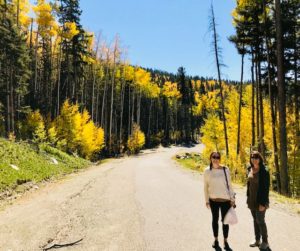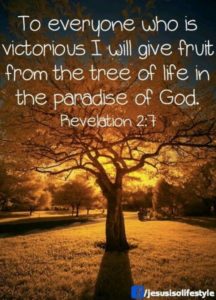A Short Meditation on Trees in the Bible

SANTA FE, NEW MEXICO—There’s something about the splendor of trees that are attractive. Maybe it’s the tangled beauty of leaves, bark, branches, and trunk, a life-giving organism of strength and stamina. Or maybe it’s the hidden world of roots, leaves, photosynthesis, carbon dioxide, and oxygen. It’s probably both: the confluence of majesty and mystery—the seen and unseen—that make trees marvelous objects of contemplation.
Two recent incidents brought the magnificence of tress to mind.
One, a friend gave me a book named Devotions On Trees Of The Bible. The author is Grace Pleasant Wellborn. In the book, Wellborn uses specific trees as points of discussion concerning the character and nature of God, finding symbolism and solace in trees. In the book Wellborn writes, “Somehow the trees held out a hope of peace and better understanding for [people] of the world—a hope for an era of better living.”

The second event was a short trip to the Santa Fe National Forest with my wife and daughter to view the Aspen’s color transformation—a picture of renewal, conserving both water and energy through the foliage change and eventual fall, and providing a spectacle of magnificent hue.
As I walk the Aspens, two questions come to mind: One, when is a tree first mentioned in the Bible? And, two, how does the Bible represent trees?
When is a tree first mentioned in the Bible?
The answer to the first question is clear: Genesis 1. Genesis 1: 11 lists trees as created on day three. The tree mentioned in the text is a fruit tree: “the fruit tree that yields fruit according to its kind…”. The specific type of fruit tree is unknown. The Hebrew word used for tree is ets (ates), meaning tree or wood. The word for fruit, p’riy, is a general name describing all fruit, not a specific fruit. In Devotions On Trees Of The Bible, Wellborn muses if the tree is a fig tree, since figs covered Adam and Eve after they disobeyed God (Genesis 3:7).
Furthermore, Wellborn postulates concerning the fruit tree, linking it to the Tree of Knowledge. She writes, “Because Adam and Eve clothed themselves with fig trees, some legends claim that the ‘tree of knowledge’ in the Garden of Eden was a fig tree.”
We don’t know for certain; the text isn’t specific enough. But what we do know is that God is the Founder of Trees, fashioning them according to “their kind.”
How does the Bible represent trees?

Throughout the Bible, authors mention trees often. Some references have direct correlation to specific events in history, such as the fig tree (discussed above), the olive tree (symbol for the nation of Israel; see Romans 11), the cedar tree (the preferred wood of choice for the temple; see I Kings 6: 9-20), and the oak tree (used as a symbol of longevity).
More generally, trees are representative/symbolic of certain characteristics. The following is but a short list:
- Pain: “Because you have listened to the voice of your wife and have eaten of the tree of which I commanded you, ‘You shall not eat of it,’ cursed is the ground because of you; in pain you shall eat of it all the days of your life.” Genesis 3:17.
- Rootedness: “He is like a tree planted by water, that sends out its roots by the stream, and does not fear when heat comes, for its leaves remain green, and is not anxious in the year of drought, for it does not cease to bear fruit.” Jeremiah 17:8
- Prosperity: “He is like a tree planted by streams of water that yields its fruit in its season, and its leaf does not wither. In all that he does, he prospers.” Psalm 1:3.
- Hope: “For there is hope for a tree, if it be cut down, that it will sprout again, and that its shoots will not cease.” Job 14:7
- Praise: “Then shall the trees of the forest sing for joy before the Lord, for he comes to judge the earth.” I Chronicles 16:33.
- Righteousness: “To grant to those who mourn in Zion— to give them a beautiful headdress instead of ashes, the oil of gladness instead of mourning, the garment of praise instead of a faint spirit; that they may be called oaks of righteousness, the planting of the Lord, that he may be glorified.” Isiah 61:3.
- Fruitfulness: “So, every healthy tree bears good fruit, but the diseased tree bears bad fruit.” Matthew 7:17
- Shelter: “On the mountain heights of Israel I will plant it; it will produce branches and bear fruit and become a splendid cedar. Birds of every kind will nest in it; they will find shelter in the shade of its branches.” Ezekiel 17:23.
- Healing: “Through the middle of the street of the city; also, on either side of the river, the tree of life with its twelve kinds of fruit, yielding its fruit each month. The leaves of the tree were for the healing of the nations.” Revelation 22:2

Revelation 2:7 - Life: “He who has an ear, let him hear what the Spirit says to the churches. To the one who conquers I will grant to eat of the tree of life, which is in the paradise of God.” Revelation 2:7.
Jesus’ Use of Trees
Trees also find a role in Jesus’ life and ministry:
- Jesus called Zacchaeus down from a tree, offering salvation. Luke 19: 1-10.
- Jesus cursed a fig tree to make a point. Mark 11: 12-14.
- Jesus used trees in his parables: Matthew 13:32.
- Palm trees/leaves make a path for Jesus. John 18.
- Jesus prays among olive trees in the Garden of Gethsemane before his crucifixion. Luke 22: 39.
- Jesus carried, and later was crucified on, a cross made from tree wood. John 19:17 and Luke 23.

So, beyond the beauty and symbolism of trees, maybe Wellborn’s point made above is correct: trees do offer hope and peace, a better understanding of truth for the world.
As I ponder trees, one thing rings true: That which God made—trees (Gen 1:11), He chose to die upon (Matthew 27:45-53), a picture of both harmony in living and hope in death. This harmony-hope image provides a clear image of the Creator among His creation (the incarnation). And in the changing colors and eventual fall of leaves and trees, believers have an understanding that that the Lord is both the Author and Finisher, the Giver and the Taker, the Revealer and Restorer, of all He made.
For Bible versus mentioning trees, click here: https://www.openbible.info/topics/trees






